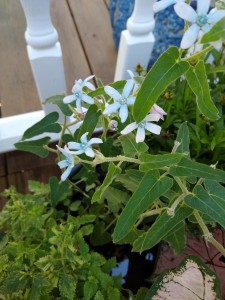 This year has been a great one for monarch butterflies—at least in my neighborhood—and that makes me feel hopeful. In fact, the news about climate change has been so dire that every monarch sighting is a celebration.
This year has been a great one for monarch butterflies—at least in my neighborhood—and that makes me feel hopeful. In fact, the news about climate change has been so dire that every monarch sighting is a celebration.
Some butterflies are rapid flyers, navigating the air in a blur of beating wings. But monarchs often float on the breezes, allowing for maximum admiration of their orange and black markings. As a gardener and nature lover, I can’t admire those gorgeous monarch wings without thinking about milkweed or Asclepias, the plant genus that the butterflies favor for nectar and caterpillar nourishment.
My garden is home to butterfly weed or Asclepias tuberosa and swamp milkweed, otherwise known as Asclepias incarnata. Both lure the passing monarchs, though I haven’t discovered any eggs or caterpillars on them. It’s possible that those tame, domesticated plant species find less favor with monarchs than the common milkweed—Asclepias syriaca—that frequents country roadsides, field edges and other sunny, undeveloped sites.
My milkweed collection has just swelled with the addition of a tropical cousin, vining blue milkweed or Tweedia cearulea.
The Latin genus name has nothing to do with tweed fabric and everything to do with James Tweedie, nineteenth century plant collector and gardener, who made a first career at the Edinburgh Botanic Garden, then emigrated and made a second career collecting plants in South America. “Caerulea” means “blue” and it refers to the sky-blue tweedia flowers.
The familiar temperate zone milkweeds often bear dense, fragrant clusters or heads of tiny flowers. By contrast, blue milkweed is more relaxed and features single five-petaled blooms. Each one is about half an inch in diameter. Mature plants may cover themselves with scores of them.
My blue milkweed is a young plant, barely twelve inches tall. If left to its own devices in a hospitable climate and appropriate support, it might reach ten feet. Growing in a container with a small trellis and overwintering indoors, it will probably max out at three feet.
Tweedia stems are covered with fine, soft hairs, as are the elongated, heart-shaped leaves. Both are pleasant to touch. In keeping with the “milkweed” moniker, the stems contain a milky sap that may irritate the skin of susceptible individuals.
Blue milkweed seedpods are almost as showy as the flowers. When young they look like slender pea pods upholstered in fine green suede. Maturing to brown, they finally split, liberating seeds that float far and wide, borne aloft by bits of attached fluff.
My new blue milkweed is getting acclimated on the back porch, but will eventually spend the rest of the growing season in a sunny, protected space in the back garden. When night temperatures dip into the fifties, it will migrate into the house. Since it is confined to a pot, I’ll fertilize while it is in active growth and stop in winter. To stimulate bushy new growth, I’ll also cut it back next spring before it goes outside.
Will monarchs flock to a blooming tweedia? Apparently not, according to at least one butterfly website, which also notes that if monarch eggs are manually moved to blue milkweed plants, the caterpillars that hatch from them will munch the leaves and thrive. My uncle used to discourage finicky eating by growling, “Eat something near you.” It’s clear that monarch caterpillars hatched on tweedia leaves follow that same line of reasoning.
Blue milkweed has acquired several other descriptive nicknames over the years, including southern star, star of the Argentine, silkpods and star flower. Whatever you call it, it is a lovely plant. You can order seeds from numerous vendors on Amazon. If plants are more to your taste, check local nurseries or garden centers for availability. You will not find tweedia at big box stores. You can also buy one from Flowers by the Sea, a California-based nursery. Find them by calling (707) 877-1717 or clicking on http://www.fbts.com. Blue milkweed is currently out of stock at Flowers by the Sea, but if you contact them, they will notify you when the plants become available again.
